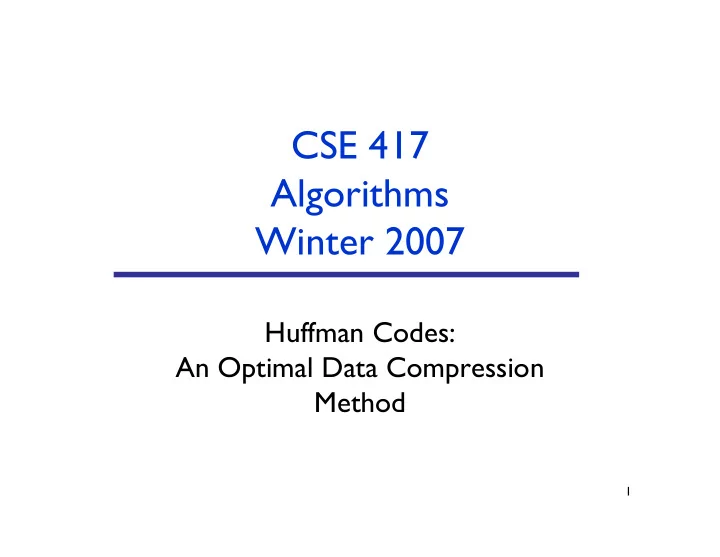

CSE 417 Algorithms Winter 2007 Huffman Codes: An Optimal Data Compression Method 1
a 45% b 13% Compression Example c 12% d 16% e 9% f 5% 100k file, 6 letter alphabet: File Size: ASCII, 8 bits/char: 800kbits 2 3 > 6; 3 bits/char: 300kbits Why? Storage, transmission vs 1Ghz cpu 2
a 45% b 13% Compression Example c 12% d 16% e 9% f 5% 100k file, 6 letter alphabet: File Size: E.g.: Why not: ASCII, 8 bits/char: 800kbits a 00 00 2 3 > 6; 3 bits/char: 300kbits b 01 01 better: d 10 10 2.52 bits/char 74%*2 +26%*4 : 252kbits c 1100 110 e 1101 1101 Optimal? f 1110 1110 1101110 = cf or ec? 3
Data Compression Binary character code (“code”) each k-bit source string maps to unique code word (e.g. k=8) “compression” alg: concatenate code words for successive k-bit “characters” of source Fixed/variable length codes all code words equal length? Prefix codes no code word is prefix of another (unique decoding) 4
a 45% b 13% Prefix Codes = Trees c 12% d 16% e 9% f 5% 1 0 1 0 0 0 0 0 1 1 1 0 0 0 1 0 1 f a b f a b
a 45% b 13% Greedy Idea #1 c 12% d 16% e 9% f 5% Put most frequent under root, then recurse … 100 . a:45 . . . . 6
a 45% b 13% Greedy Idea #1 c 12% d 16% e 9% f 5% Put most frequent under root, then recurse 100 Too greedy: a:45 55 unbalanced tree .45*1 + .16*2 + .13*3 … = 2.34 not too bad, but imagine if all d:16 29 freqs were ~1/6: (1+2+3+4+5+5)/6=3.33 . . b:13 . 7
a 45% b 13% Greedy Idea #2 c 12% d 16% e 9% f 5% Divide letters into 2 groups, with ~50% 100 weight in each; recurse (Shannon-Fano code) 50 50 Again, not terrible 2*.5+3*.5 = 2.5 But this tree a:45 f:5 25 25 can easily be improved! (How?) b:13 c:12 d:16 e:9 8
a 45% b 13% Greedy idea #3 c 12% d 16% e 9% f 5% Group least frequent letters near bottom 100 . . . . . . 25 14 c:12 b:13 f:5 e:9 9
.45*1 + .41*3 + .14*4 = 2.24 bits per char
Huffman’s Algorithm (1952) Algorithm: insert node for each letter into priority queue by freq while queue length > 1 do remove smallest 2; call them x, y make new node z from them, with f(z) = f(x) + f(y) insert z into queue Analysis: O(n) heap ops: O(n log n) Goal: Minimize � B ( T ) = freq(c)*depth(c) c � C Correctness : ??? 12
Correctness Strategy Optimal solution may not be unique, so cannot prove that greedy gives the only possible answer. Instead, show that greedy’s solution is as good as any. 13
Defn: A pair of leaves is an inversion if depth(x) ≥ depth(y) and freq(x) ≥ freq(y) Claim: If we flip an inversion, cost never increases. Why? All other things being equal, better to give more frequent letter the shorter code. before after (d(x)*f(x) + d(y)*f(y)) - (d(x)*f(y) + d(y)*f(x)) = (d(x) - d(y)) * (f(x) - f(y)) ≥ 0 I.e. non-negative cost savings.
Lemma 1: “Greedy Choice Property” The 2 least frequent letters might as well be siblings at deepest level Let a be least freq, b 2 nd Let u, v be siblings at max depth, f(u) ≤ f(v) (why must they exist?) Then (a,u) and (b,v) are inversions. Swap them. 15
Lemma 2 Let (C, f) be a problem instance: C an n-letter alphabet with letter frequencies f(c) for c in C. For any x, y in C, let C’ be the (n-1) letter alphabet C - {x,y} ∪ {z} and for all c in C’ define f'(c) = � f(c), if c � x,y,z � f(x) + f(y), if c = z � Let T’ be an optimal tree for (C’,f’). Then T’ = z T x y is optimal for (C,f) among all trees having x,y as siblings 16
Proof: � B ( T ) = d T ( c ) � f ( c ) c � C B ( T ) � B ( T ') = d T ( x ) � ( f ( x ) + f ( y )) � d T ' ( z ) � f '( z ) = ( d T ' ( z ) + 1) � f '( z ) � d T ' ( z ) � f '( z ) = f '( z ) ˆ T Suppose (having x & y as siblings) is better than T, i.e. ˆ B ( ˆ T ' Collapse x & y to z, forming ; as above: T ) < B ( T ). B ( ˆ ) � B ( ˆ T T ') = f '( z ) Then: B ( ˆ ') = B ( ˆ T T ) � f '( z ) < B ( T ) � f '( z ) = B ( T ') Contradicting optimality of T’
Theorem: Huffman gives optimal codes Proof: induction on |C| Basis: n=1,2 – immediate Induction: n>2 Let x,y be least frequent Form C´, f´, & z, as above By induction, T´ is opt for (C ´,f´) By lemma 2, T´ → T is opt for (C,f) among trees with x,y as siblings By lemma 1, some opt tree has x, y as siblings Therefore, T is optimal. 18
Data Compression Huffman is optimal. BUT still might do better! Huffman encodes fixed length blocks. What if we vary them? Huffman uses one encoding throughout a file. What if characteristics change? What if data has structure? E.g. raster images, video,… Huffman is lossless. Necessary? LZW, MPEG, … 19
20 David A. Huffman, 1925-1999
21
22
Recommend
More recommend